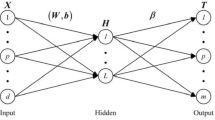Abstract
Extreme learning machines (ELM) have been applied in several fields due to their simplicity and computational efficiency. However, ELM hurts the performance in cross-domain learning problems similar to most machine learning algorithms. In this paper, we mainly focus on the semi-supervised transfer learning algorithm under ELM framework. Unlike other transfer learning methods employed both source and target domains, we propose a target adaptive ELM (TAELM) of learning a high-quality target-specific classifier with less resources. We formulate a novel objective function to obtain a target-specific classifier by introducing a knowledge transfer term on a pre-trained source model and a graph laplacian-based manifold regularization term on the target domain, while its solution are analytically determined without loss of the computing efficiency and learning ability of traditional ELM. In our experiments, we verify the effectiveness of the proposed approach by using a deep neural network model as feature extractor for both domains. Experimental results demonstrate that our method with less resources significantly outperforms other state-of-the-art algorithms.





Similar content being viewed by others
Data availability
Data sharing not applicable to this article as no datasets were generated or analysed during the current study.
References
Chang P, Zhang J, Wang J, Fei R (2020) ELMAENet: a simple, effective and fast deep architecture for image classification. Neural Process Lett 51:129–146
Chen C, Jiang B, Jin X (2018) Parameter transfer extreme learning machine based on projective model, in Proceedings of the International Joint Conference on Neural Networks (IJCNN 2018), pp. 18, IEEE, Rio de Janeiro, Brazil
Chen Y, Song S, Li S, Yang L, Wu C (2019) Domain space transfer extreme learning machine for domain adaptation. IEEE Trans Cybern 49(5):1909–1922
Donahue J, Jia Y, Vinyals O, Hoffman J, Zhang N, Tzeng E, Darrell T (2013) DeCAF: a deep convolutional activation feature for generic visual recognition, arXiv: 1310.1531
Eshtay M, Faris H, Obeid N (2018) Improving extreme learning machine by competitive swarm optimization and its application for medical diagnosis problems. Expert Syst Appl 104:134–152
Ghoneim A, Muhammad G, Hossain MS (2020) Cervical cancer classification using convolutional neural networks and extreme learning machines. Futur Gener Comput Syst 102:643–649
Huang G-B, Zhu Q-Y, Siew CK (2006) Extreme learning machine: theory and applications. Neurocomputing 70(1–3):489–501
Huang G-B, Zhou H, Ding X, Zhang R (2012) Extreme learning machine for regression and multiclass classification. IEEE Trans Syst Man Cybern Part B (Cybernetics) 42(2):513–529
Huang G, Song S, Gupta JND, Wu C (2014) Semi-supervised and unsupervised extreme learning machines. IEEE Trans Cybern 44(12):2405–2417
Jing M-M, Zhao J-D, Li J-J, Zhu L, Yang Y, Shen H-T (2021) Adaptive component embedding for domain adaptation. IEEE Trans Cybern 51(7):3390
LeCun Y, Bottou L, Bengio Y, Haffner P (1998) Gradient based learning applied to document recognition. Proc IEEE 86(11):2278–2324
Li H, Yang X, Li Y, Hao L-Y, Zhang T-L (2020) Evolutionary extreme learning machine with sparse cost matrix for imbalanced learning. ISA Trans 100:198–209
Li S, Song S, Huang G, Wu C (2018) Cross-domain extreme learning machines for domain adaptation. IEEE Trans Syst Man Cybern 49(6):1194–1207
Li C-L, Lin L, Zuo W-M, Tang J, Yang M-H (2019) Visual tracking via dynamic graph learning. IEEE Trans Pattern Anal Mach Intell 41(11):2770–2782
Liu O, Chen G-L, Lin H-C, Zhang W-P, Liu J-Q (2021) Prediction of IGBT junction temperature using improved cuckoo search-based extreme learning machine. Microelectron Reliab 124:114267
Lu J-L, Zhou J, Chen Y-D, Pedrycz W, Hung K-W (2022a) Asymmetric Transfer Hashing with Adaptive Bipartite Graph Learning, arXiv:2206.12592v2
Lu J-L, Wang H-L, Zhou J, Chen Y-D, Lai Z-H, Hu Q-H (2021) low-rank adaptive graph embedding for unsupervised feature extraction. Pattern Recogn 113:107758
Lu S-Y, Zhang Z, Zhang Y-D, Wang S-H (2022) CGENet: a deep graph model for COVID-19 detection based on chest CT. Biology 11(11):33
Lu S-Y, Wang S-H, Zhang Y-D (2021) Detection of abnormal brain in MRI via improved AlexNet and ELM optimized by chaotic bat algorithm. Neural Comput Appl 33(17):10799–10811
Ma Z-Y, Luo G-C, Qin K, Wang N, Niu W-N (2018) Weighted domain transfer extreme learning machine and its online version for gas sensor drift compensation in E-Nose systems. Wireless Commun Mobile Comput. https://doi.org/10.1155/2018/2308237
Muhammad AK, Seifedine K, Zhang Y-D, Tallha A, Muhammad S, TanzilaSaba RA (2021) Prediction of COVID-19—Pneumonia based on selected deep features and one class kernel extreme learning machine. Comput Electr Eng 90:106960
Netzer Y, Wang T, Coates A, Bissacco A, Wu B, Ng AY (2011) Reading digits in natural images with unsupervised feature learning. NIPS Workshop Deep Learning Unsupervised Feature Learn 2011:5
Noh Y, Sugiyama M, Liu S, Plessis MCD, Park FC (2018) Bias reduction and metric learning for nearest neighbor estimation of Kullback-Leibler divergence. Neural Comput 30(7):1930–1960
Zyurt FO (2020) A fused CNN model for WBC detection with MRMR feature selection and extreme learning machine. Soft Comput 24:8163–8172
Pan S-J, Yang Q (2010) A survey on transfer learning. IEEE Trans Knowl Data Eng 22(10):1345–1359
Raghuwanshi BS, Shukla S (2020) SMOTE based class-specific extreme learning machine for imbalanced learning. Knowl Based Syst 187:229–242
Rajabi A, Mousavi S, Mohamadian N, Wood DA, Ghorbani H, Davoodi S, Alvar MA, Shahbazi K (2021) Hybrid machine learning algorithms to predict condensate viscosity in the near wellbore regions of gas condensate reservoirs. J Nat Gas Sci Eng 95:104210
Ri J-H, Liu L, Liu Y, Wu H-F, Huang W-L, Kim H (2018) Optimal weighted extreme learning machine for imbalanced learning with differential evolution. IEEE Comput Intell Mag 13(3):32–47
Ri J-H, Tian G-Z, Liu Y, Xu W-H, Lou J-G (2020) Extreme learning machine with hybrid cost function of G-mean and probability for imbalance learning. Int J Mach Learn Cybern 11(9):2007–2020
Song G, Dai Q, Han X, Guo L (2020) Two novel ELM-based stacking deep models focused on image recognition. Appl Intell 50:345–1366
Tian X-H, Jiao W-L, Liu T-J, Ren L-M, Song B (2021) Leakage detection of low-pressure gas distribution pipeline system based on linear fitting and extreme learning machine. Int J Press Vessels Pip 194:104553
Tommasi T, Orabona F, Caputo B (2014) Learning categories from few examples with multi model knowledge transfer. IEEE Trans Pattern Anal Mach Intell 36(5):928–941
Wu C, Li Y, Zhao Z, Liu B (2020) Extreme learning machine with autoencoding receptive fields for image classification. Neural Comput Appl 32:8157–8173
Yan H, Ding Y, Li P, Wang Q, Xu Y, Zuo W (2017) Mind the class weight bias: weighted maximum mean discrepancy for unsupervised domain adaptation, in proceedings of the IEEE International conference on computer vision (CVPR), Hawaii United States. p. 945–954
Zang S-F, Cheng Y-H, Wang X-S, Yan Y-Y (2021) Transfer extreme learning machine with output weight alignment. Comput Intel Neurosci. https://doi.org/10.1155/2021/6627765
Zhang J, Li Y, Xiao W, Zhang Z (2020) Non-iterative and fast deep learning: multilayer extreme learning machines. J Franklin Inst 357:8925–8955
Zhang L, Zhang D (2015) Domain adaptation extreme learning machines for drift compensation in E-nose systems. IEEE Trans Instrum Meas 64(7):1790–1801
Zhang L, He Z, Liu Y (2017) Deep object recognition across domains based on adaptive extreme learning machine. Neurocomputing 239:194–203
Zhu H-H, Liu G-J, Zhou M-C, Xie Y, Abusorrah A, Kang Q (2020) Optimizing weighted extreme learning machines for imbalanced classification and application to credit card fraud detection. Neurocomputing 407:50–62
Author information
Authors and Affiliations
Corresponding author
Ethics declarations
Conflict of interest
The authors declare that they have no conflict of interest and no relevant financial or non-financial interests to disclose.
Additional information
Publisher's Note
Springer Nature remains neutral with regard to jurisdictional claims in published maps and institutional affiliations
Rights and permissions
Springer Nature or its licensor (e.g. a society or other partner) holds exclusive rights to this article under a publishing agreement with the author(s) or other rightsholder(s); author self-archiving of the accepted manuscript version of this article is solely governed by the terms of such publishing agreement and applicable law.
About this article
Cite this article
Ri, J.H., Kang, T.G. & Choe, C.R. Target adaptive extreme learning machine for transfer learning. Int. J. Mach. Learn. & Cyber. 15, 917–927 (2024). https://doi.org/10.1007/s13042-023-01947-x
Received:
Accepted:
Published:
Issue Date:
DOI: https://doi.org/10.1007/s13042-023-01947-x




